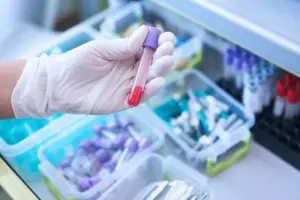Discover the intricacies of Chorionic Villus Testing with our detailed explanation, including trophoblastic test procedures, costs, and how it differs from amniocentesis. Expert supervision by our doctors ensures comprehensive and reliable information for your prenatal care.
- Introduction
- What is chorionic villus testing?
- What is amniotic fluid testing?
- What is the difference between chorionography and amniocentesis?
- Detailed description of NIPT, which can be done before trophoblastic testing
- Advantages of performing NIPT before trophoblastic testing
- Chorionic villus testing is on the decline
- Differences between NIPT and maternal serum markers
- Differences between NIPT in Japan and the USA
- Choice of NIPT plans by Hiro Clinic NIPT
- NIPT at Hiro Clinic NIPT is easy to book
- No age limit for NIPT at Hiro Clinic NIPT
- Cases of inaccurate test results with NIPT
- First, try the low-risk NIPT
- Advantages of performing NIPT before trophoblastic testing
- Summary
Introduction
Tests to check for chromosomal abnormalities and congenital diseases in the foetus before delivery are called prenatal diagnosis. The two main types of prenatal diagnosis performed so far are chorionic villus and amniotic fluid tests, both of which are definitive tests to detect chromosomal abnormalities and congenital diseases in the foetus.
While definitive, chorionic villus and amniotic fluid tests should be carefully considered before undergoing them, as they can damage both the mother and the foetus in some cases.
For this reason, an increasing number of mothers are undergoing NIPT, a non-confclusive test that detects possible risks such as chromosomal abnormalities and congenital diseases in the foetus, before prenatal diagnosis by trophoblastic and amniotic fluid tests, which are considered risky for the mother and foetus.
This article provides detailed information on the difference between the two prenatal diagnostic methods, the chorionic villus test and the amniotic fluid test, and on NIPT, which is considered to be highly safe.
What is chorionic villus testing?
A trophoblastic examination is a test in which the trophoblastic tissue in the placenta is sampled in early pregnancy to diagnose chromosomal abnormalities and congenital diseases (hereafter referred to as congenital diseases) in the foetus before delivery.
In most cases, the trophoblastic examination is carried out between 10 and 13 weeks of pregnancy.
The timing of the test often differs from one medical centre to another. It is important to find out in advance, as some institutions can perform the test from 10 weeks’ gestation, while others will not accept the test until 14 weeks’ gestation or later.
NIPT is another testing method that can detect the risk of chromosomal abnormalities and congenital diseases in babies from the 10th week of pregnancy.
It is reported that an increasing number of mothers are now using NIPT, which has less impact on the baby, to first investigate the risk of chromosomal abnormalities and congenital diseases, and then consider a definitive test such as a trophoblastic test or amniotic fluid test if a positive result is found.
Inspection methods
Trophoblasts are a part of the tissue in the placenta. Trophoblastic trophoblastic examination is a definitive test for chromosomal abnormalities and congenital diseases of the baby by collecting and culturing the trophoblastic cells.
The method of trophoblastic examination varies from person to person depending on the location of the placenta and other factors. There are two methods: the transabdominal method, in which trophoblastic cells are extracted from the mother’s lower abdomen with a special needle, and the transvaginal method, in which trophoblastic cells are extracted from the vagina with a special medical device.
Both transabdominal and transvaginal trophoblastography avoid the risk of invasion (damage) to the mother and baby during the examination by placing an echo (ultrasound device) on the mother’s abdomen to confirm the position of the placenta and baby.
Transabdominal method
This test is often performed when the mother’s placenta is located on the anterior wall or bottom of the uterus. A special needle is used to puncture the mother’s lower abdomen and collect trophoblastic cells while the placenta and baby are visually observed with an echo.
The trophoblastic examination is performed under local anaesthesia and is therefore considered to be painless. Immediately after anaesthesia wears off, the patient may experience some minor pain, which will subside in a few days. If you experience any abnormalities during a trophoblastogram (transabdominal method), such as persistent pain or discomfort at the puncture site, consult the medical institution where you had the trophoblastogram immediately.
Transvaginal method
This test is often performed when the mother’s placenta is located close to the back wall of the uterus or the cervix. A special medical instrument called a trophoblastic forceps is inserted into the vagina to collect the trophoblastic cells while the placenta and baby are visually positioned with an echo.
In the case of a transvaginal trophoblastic examination, it is not uncommon for a small amount of bleeding to continue after the examination. It is important to listen to your doctor’s explanation beforehand and not to panic about bleeding after the test. Bleeding should subside within a day or two, but if you notice any abnormalities, such as heavy bleeding or bleeding that does not stop, consult the medical institution where you had the trophoblastic examination immediately.
Duration of test results
The results of the trophoblastic test can be known in about 2-3 weeks.
The proportion of older pregnancies and births is on the rise as women enter the workforce. However, as women age, the number of eggs declines, causing chromosomal abnormalities and congenital diseases in the foetus, and many women wish to have a trophoblastic trophoblastic examination as a prenatal diagnosis.
However, since trophoblastic testing is invasive (damaging) to the mother and foetus and carries a miscarriage risk of approximately 1%, why not first consider NIPT, which does not involve direct invasion of the foetus?
Inspection fees
The cost of a chorionic villus examination is entirely self-paid and very expensive. The cost varies from medical institution to medical institution, but is estimated to be approximately JPY 100,000-200,000. If hospitalisation is required for a trophoblastic examination, it is advisable to check the total cost in advance at the medical institution, as hospitalisation and other costs will be added to the examination fee.
What is amniotic fluid testing?
Amniotic fluid testing is a method of testing that involves taking a sample of amniotic fluid from the womb and using the cells in the amniotic fluid to check the chromosomes and genetic make-up of the foetus.
Although amniofiltration is a definitive test, it cannot be said to cause zero invasion (damage) to the foetus as a needle is inserted into the mother’s abdomen. The risk of miscarriage is estimated to be about 0.3%.
For these reasons, an increasing number of mothers undergo NIPT, which is not directly invasive to the foetus, first, and then move on to amniotic fluid testing, which is a definitive test, after the possibility of chromosomal abnormalities has been detected.
Before undergoing the amniotic fluid test, which carries a miscarriage risk of approximately 0.3%, why not consider the NIPT, which is 0% invasive to the baby?
Inspection methods
The amniotic fluid examination is also carried out using an echo (ultrasound device) to visually check the amount of amniotic fluid and the position of the baby.
A needle is inserted into the mother’s lower abdomen and 10-20 ml of amniotic fluid is collected. In some cases, an anaesthetic is not used for the amniotic fluid test, as the pain caused by the needle puncture is minimal, but those who are sensitive to pain can undergo an amniotic fluid test after consulting a doctor in advance.
The amniotic fluid sample for an amniotic fluid test is taken in a very short period of time, lasting only 20 seconds. However, after the test, the patient must rest for about 30 minutes and make sure that no physical problems occur. Therefore, the time needed for an amniotic fluid test is estimated to be about one hour.
Duration of test results
The time taken for the test results to be confirmed is approximately three weeks.
Amniotic fluid testing cannot immediately confirm the cell chromosomes from the amniotic fluid.
The cells in the amniotic fluid have to be grown, which requires a culture process that takes about two weeks.
The chromosomes are then tested and assessed, which takes time.
Inspection fees
Amniotic fluid testing is also not covered by insurance. Therefore, the entire cost is to be paid out-of-pocket.
The cost of the test is different at each medical institution or clinic, but is estimated to be approximately 100 000-200 000 yen.
As there is a medical examination before the amniotic fluid test, there are often additional costs in addition to the amniotic fluid test. It is important to find out the total cost in advance to avoid panic when paying the bill.
What is the difference between chorionography and amniocentesis?
Chorionic villus and amniotic fluid tests are the same definitive test, but differ in terms of the number of weeks of pregnancy at which the test is performed and the tissue site from which it is taken. Let’s compare the advantages and disadvantages of trophoblastic and amniotic fluid tests.
Advantages of chorionic villus testing
Time of inspection
The chorionic villus test can be performed at ’10-13 weeks’ gestation, whereas the amniotic fluid test can only be performed at ’15-17 weeks’ gestation, so the chorionic villus test can be performed earlier.
More and more mothers are undergoing ‘NIPT’ as a preliminary step to both chorionic villus and amniotic fluid tests.
If the test is positive, you can have the trophoblastic test at an earlier stage and you will know the test results earlier.
Quantity of cells that can be collected
The chorionic villus test can collect a greater quantity of cells from the baby than the amniotic fluid test.
This makes the test ideal for chromosomal and genetic diagnosis and provides accurate genetic test results.
Disadvantages of chorionic villus testing
1% risk of miscarriage
The disadvantage of chorionic villus testing is that there is a 1% risk of miscarriage. Based on clinical research, chorionic villus testing has a higher risk of miscarriage than amniocentesis.
The reason for this is that chorionic villus tests are performed at an early stage of pregnancy and the earlier in pregnancy, the more likely a miscarriage will occur.
Make sure you know this information before carrying out a trophobic or amniotic fluid test.
Risk of bleeding, water breaking, intrauterine infection, premature birth, etc
These are not highly probable, but chorionic villus examinations can cause them.
The transabdominal method involves inserting a needle into the abdomen, which can cause inflammation of the peritoneum, a membrane inside the abdomen, which can lead to peritonitis and infection.
The transvaginal method can also cause infections such as peritonitis if the forceps reaches the abdomen.
Amniotic fluid testing may have to be carried out after chorionic villus testing
If the results of the trophoblastic test show ‘placental mosaicism’, a further amniocentesis may be performed afterwards.
Placental mosaicism’ is a condition in which both abnormal and normal chromosomes are identified, meaning that the trophoblastic test cannot give accurate results.
If desired for this reason, an amniotic fluid test can be performed to check whether the baby really has chromosomal abnormalities or other abnormalities.
Limited facilities
Clinical research-based chorionic villus testing is a highly technical test method and the number of hospitals and clinics that can perform this test is limited.
Detailed description of NIPT, which can be done before trophoblastic testing
NIPT is a test to determine whether a baby is ‘positive’ or ‘negative’ for chromosomal abnormalities or congenital diseases by simply taking a blood sample from the mother’s arm. NIPT is a ‘non-confirmatory’ test to determine the likelihood of a positive result with high accuracy, while a trophoblastic test is considered a ‘definitive test’ to check for the presence of chromosomal abnormalities or congenital diseases in the baby.
Advantages of performing NIPT before trophoblastic testing
Trophoblastic trophoblastic testing began in 1973. In 1983, the method was improved and made safer by using ultrasound to collect the trophoblastic tissue, leading to the current method of trophoblastic examination. The method has been improved and is the current method of trophoblastic trophoblastic examination.
Trophoblastic trophoblastic trophoblastic examination can be performed from 10-13 weeks’ gestation. Trophoblastic trophoblastic trophies are a definitive test to diagnose chromosomal abnormalities and congenital diseases in babies, but the risk of miscarriage is approximately 1%.
he only specimen required for NIPTis the mother’s blood. As neither syringe puncture nor trophoblast sampling with trophoblast biopsy forceps is required, the direct risk to the baby is very low. For these reasons, Hiro Clinic NIPT proposes the highly safe NIPT in order to protect your precious baby from the risks of prenatal diagnosis.
Chorionic villus testing is on the decline
Chorionic villus examination, a form of prenatal diagnosis, can be performed as early as 10 weeks’ gestation. It is a definitive test for the presence of chromosomal abnormalities in the foetus, etc. The number of tests peaked in 2015 but declined by about 20% in 2019.
The risk of miscarriage from amniotic fluid testing is about 0.3%, whereas the risk of miscarriage from trophoblastic testing is about 1%. The decrease in chorionic villus testing can also be attributed to the fact that clinical research on NIPT, which allows testing from 10 weeks’ gestation and does not directly invade (damage) the foetus, began in 2013.
Differences between NIPT and maternal serum markers
In addition to NIPT, there is another prenatal diagnosis called maternal serum markers, which can be tested only with a blood sample from the mother.
Maternal serum markers are tested from 15-16 weeks’ gestation, and target conditions include Down syndrome (21 trisomy), Edwards syndrome (18 trisomy) and neural tube defects (a type of congenital abnormality that occurs in the brain, spine and spinal cord). The accuracy of maternal serum marker testing is estimated to be about 83%.
NIPT, on the other hand, is performed from 10 weeks 0 days of pregnancy and covers Down syndrome (21 trisomies), Edwards syndrome (18 trisomies), Patou syndrome (13 trisomies), all chromosomes, sex chromosomes, whole autosomal regions, partial deletions and duplication disorders. NIPT has an accuracy rate of approximately 99.1% and is a highly accurate testing method.
Differences between NIPT in Japan and the USA
NIPT test method only involves drawing about 2 teaspoons (10 ml) of blood from the mother’s arm. Compared to trophoblastic and amniotic fluid tests, which involve a puncture of the abdomen, this is a very safe test.
However, NIPT is not covered by insurance and is therefore expensive. In the USA, NIPT is covered by the health insurance company with which you are insured and is considered a common test. Hiro Clinic NIPT offers a variety of plans to ensure that the cost of NIPT does not interfere with the ‘mother’s and family’s right to know’.
Choice of NIPT plans by Hiro Clinic NIPT
At Hiro Clinic NIPT, we believe that “the mother’s and family’s right to know” is of the utmost importance. We have prepared a variety of original plans for Hiro Clinic NIPT to ensure that no mother gives up on NIPT because of the high cost, and that as many mothers as possible can have a healthy birth with low risk through NIPT.
The simplest NIPT plan starts at JPY 48,800 (JPY 53,680 incl. tax) and allows you to choose one of the chromosomes 1 to 22 for testing. For example, you may wish to undergo testing for Down syndrome (21 trisomy) only and consider your budget for birth costs. For more information about each plan or if you have any questions, please ask Hiro Clinic NIPT staff.
NIPT at Hiro Clinic NIPT is easy to book
A mother’s mind and body are very delicate during pregnancy. At Hiro Clinic NIPT, NIPT test method, as well as booking, filling in the medical questionnaire, confirming the consent form and explaining the test, can all be done online. For mothers who have severe morning sickness or are worried about infections caused by crowds, booking and confirmation can be done in two easy steps anytime, anywhere. First, prepare your contact address and create a My Page at Hiro Clinic NIPT.
No age limit for NIPT at Hiro Clinic NIPT
There is no age limit for NIPT at Hiro Clinic NIPT. Many people are generally aware that prenatal diagnosis is a test for people over 35 years of age. It is true that the risk of chromosomal abnormalities and congenital diseases in babies increases with age, but the possibility of such diseases is not zero, even in younger mothers.
For a safe pregnancy and a healthy birth, please consider NIPT at Hiro Clinic NIPT. There is no age limit for NIPT, but if you have a positive NIPT result and plan to have an amniotic fluid test afterwards, it is recommended to have the test before 14 weeks of pregnancy. Contact Hiro Clinic NIPT for advice on when to test for NIPT.
Cases of inaccurate test results with NIPT
NIPT is considered to be a highly accurate testing method with low burden on the mother and baby and no age limit. However, NIPT cannot correctly detect trisomy or monosomy, if you have received stem cell therapy or immunotherapy, or if you have received a blood transfusion within the past 12 months.
First, try the low-risk NIPT
The trophoblastic test is a definitive test that can confirm the presence or absence of chromosomal abnormalities in the baby. However, it is not easy on the mother and baby as the cells are taken directly from the mother’s abdomen or vagina. There may also be a small amount of bleeding after the trophoblastic test, which can cause a great deal of anxiety, even if the mother and baby are informed about the test before it is performed.
To reduce the delicate emotional and physical burden of pregnancy, why not first have a NIPT at Hiro Clinic NIPT and then consider a definitive test if the result is positive?
If the Hiro Clinic NIPT NIPT is positive, the cost of the amnio test is subsidised by the Amnio Test Support. Please note that trophoblastic testing is not subsidised.
The risk of miscarriage with a trophoblastic test is estimated to be about 1%, while the risk of miscarriage with an amniocentesis test is about 0.3%. Safer and more accurate. Hiro Clinic NIPT will continue to sincerely respond to the ‘right to know for mothers and families’.
Summary
Trophoblastic testing requires a nonconfirmatory test such as NIPT as the testing stage.
If the test results are positive after that test, the patient is often moved on to a definitive test, the clinical research-based trophoblastic trophoblastic test.
The advantage of trophoblastic testing is that it is the best test for genetic and chromosomal diagnosis and can be taken early in pregnancy.
However, it is expensive as it is self-funded and the chance of miscarriage is slightly higher risk, with the probability of miscarriage being approximately 1% for trophoblastic testing, compared to approximately 0.3% for amniotic fluid testing.
It is advisable to understand this information before considering a trophoblastic test.
Hiro Clinic will help you undergo testing with peace of mind by providing up-to-date information and after-sales support based on clinical research. (Hiro Clinic uses this information as clinical research data only after obtaining your consent.)
【References】
- Japan Society of Obstetricians and Gynaecologists – NIPT, prenatal testing: future developments VS problems and limitations
- Ministry of Health, Labour and Welfare – National prenatal genetic survey
Discover the intricacies of Chorionic Villus Testing with our detailed explanation, including trophoblastic test procedures, costs, and how it differs from amniocentesis. Expert supervision by our doctors ensures comprehensive and reliable information for your prenatal care.
Article Editorial Supervisor

岡 博史先生
【役職】
【資格】
【略歴】
【所属】
【SNS】
 中文
中文













